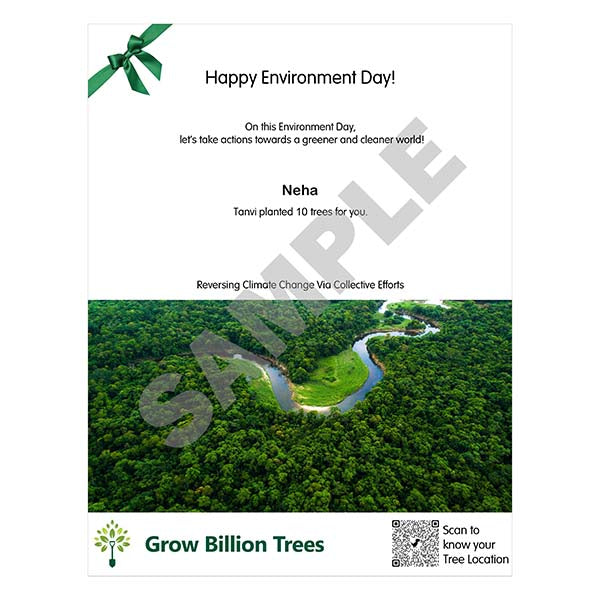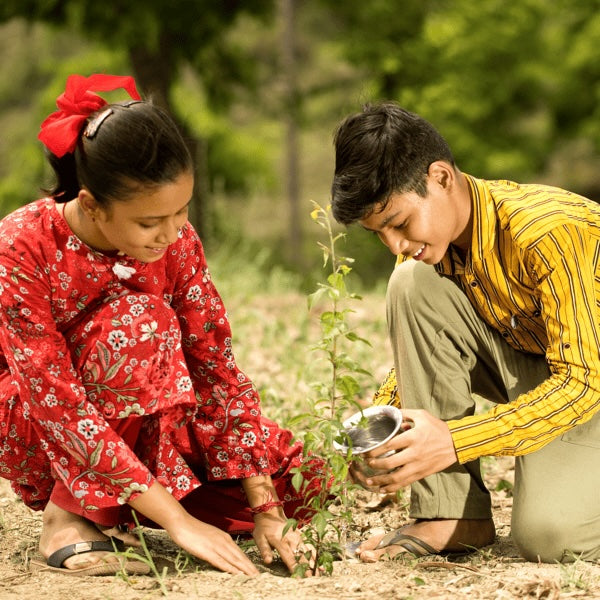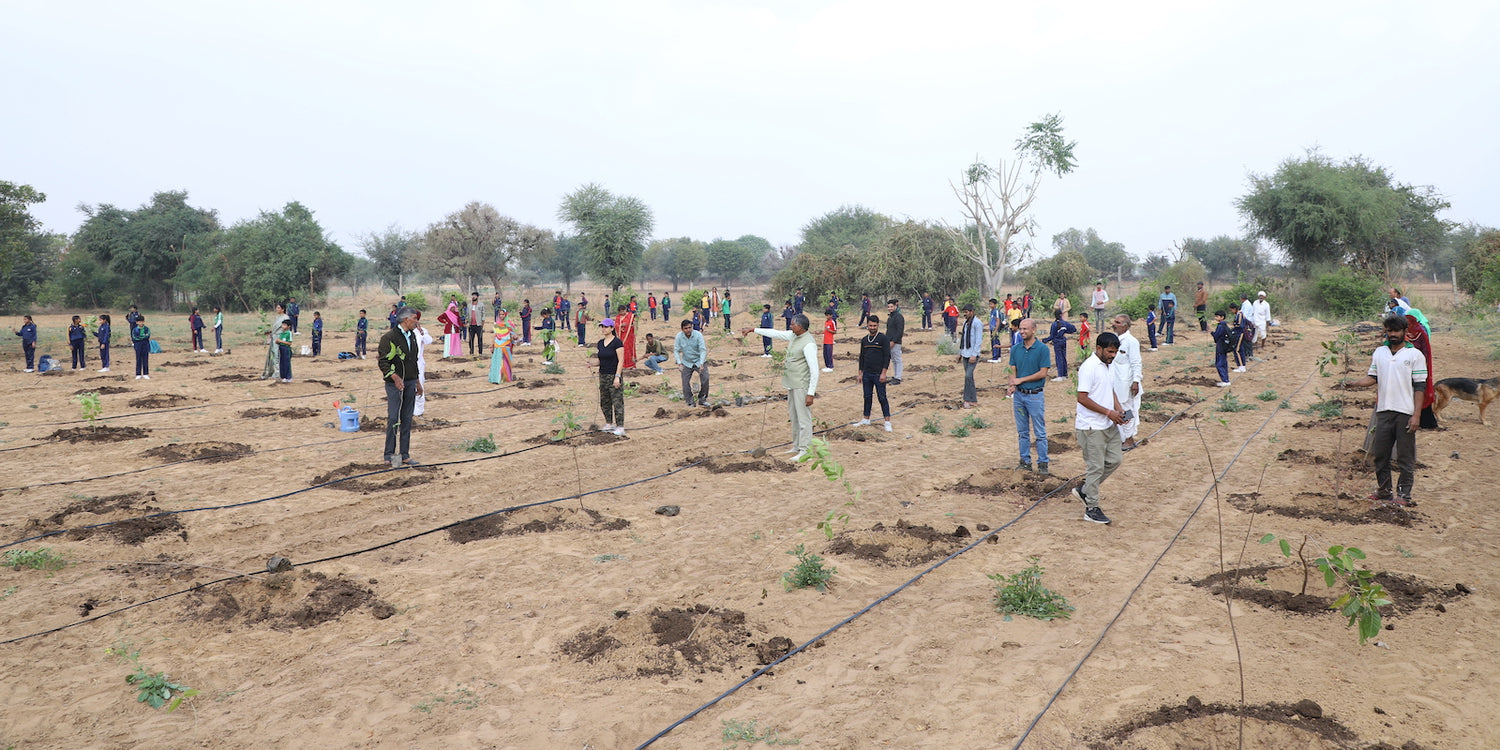Trees for Environment Day (5th Jun)
Trees for Environment Day (5th Jun)
🌳 2-3ft Tree + 3 Years Nurturing + Geo-Tagged
💡 Tip: Plant a tree on behalf of each family member
Plant trees to offset your carbon footprints
Couldn't load pickup availability
What you get ?
Tree(s) Plantation
Tree(s) Plantation
A tree(s) native to the region will be planted within 7 -10 days, and post-plantation monitoring will be thoroughly managed.
*You will receive an email/whatsapp notification immediately after the tree(s) plantation. or you can check the current status by logging into "My Account" anytime.
e-Greeting Card of Tree(s) Plantation for Gifting
e-Greeting Card of Tree(s) Plantation for Gifting
If you want to gift these tree(s) to your loved ones, You can generate an e-Greeting card for tree(s) plantation by logging into "My Account" after placing order.
*Please generate it within 5 days of placing the order.
e-Certificate of Tree(s) Plantation
e-Certificate of Tree(s) Plantation
A e-certificate of Tree(s) Plantation with the project details will be issued in your name after tree(s) plantation.
*You can download it from "My Account".
Geotag of your Tree(s)
Geotag of your Tree(s)
You can immediately track the live location of the project chosen for your tree(s) plantation, by logging into "My Account" or, by scanning the QR code on the certificate.
*You can see Your Name in respective Project/Forest.
If you want to gift these tree(s) to your loved ones, You can generate an e-Greeting card for tree(s) plantation by logging into "My Account" after placing order.
View full details


Are you ready to celebrate World Environment Day in style? Look no further than Trees for Environment Day! Our sustainably-grown trees ar Read more
Trending
Environment Day Tree Plantation: Plant a Tree, Save the Planet
Description:
Are you ready to celebrate World Environment Day in style? Look no further than Trees for Environment Day! Our sustainably-grown trees are the perfect addition to any eco-conscious celebration.
But what makes Trees for Environment Day stand out from the rest? For starters, our trees are grown with the utmost care and attention to sustainability. We use methods like companion planting, natural pest control, and organic fertilizers to ensure that our trees are as healthy for the planet.
Planting trees is one of the best ways to combat climate change, as they absorb carbon dioxide and produce oxygen. In fact, one mature tree can absorb up to 22 KGs (48 pounds) of CO2 per year! Plus, they provide a habitat for wildlife and help reduce energy costs by providing shade in the summer and windbreaks in the winter.
Scope:
- Enhancement of Biodiversity
- Increase in Green Cover
- Reduction of Man-Animal Conflict
- Generation of Rural Employment
- Improvement of Wildlife Habitats
Tree Species:
The species of trees that are planted depend on the project, and they are chosen based on their native habitat in the corresponding ecological zone.
Why trees?
Well, it's not just about planting trees on World Environment Day, it's about celebrating our planet and showing our appreciation for all the wonderful things it provides us with. And what better way to do that than by planting some trees? Here are a few reasons why you should plant trees on World Environment Day:
-
Trees are like the superheroes of the environment - they absorb carbon dioxide, produce oxygen, provide habitats for wildlife, and even help prevent soil erosion. Plus, they look pretty cool too.
-
Did you know that one mature tree can absorb up to 22 KG (48 pounds) of carbon dioxide per year? So, by planting just one tree, you're already making a big impact on the environment.
-
Trees can also help reduce energy costs - they provide shade in the summer, which can help keep your home cool and act as a windbreak in the winter, which can help reduce heating costs.
-
Planting trees can also be a great way to bring your community together. You can organize a tree-planting event and invite your friends, family, and neighbors to join in the fun. Who doesn't love a good old-fashioned tree-planting party?
-
And last but not least, planting trees is just a really nice thing to do. It's a way to give back to the planet and show that you care about the environment. Plus, it's a great excuse to get outside and enjoy nature.
So there you have it - 5 witty and interesting reasons why you should plant trees on World Environment Day. Remember, every little bit helps when it comes to protecting our planet, so go ahead and get planting!
Social Impact:
Planting trees can have a number of social and community benefits, in addition to helping to reduce carbon emissions and combat climate change. Some of the ways in which tree planting can positively impact the community include:
-
Encouraging community involvement: Planting trees as a community activity can bring people together and promote social connections.
-
Fostering a sense of belonging: Participating in a tree-planting event can help to build a sense of ownership and pride in the community.
-
Promoting education and awareness: Tree planting can provide an opportunity for education and learn about the environment, raising awareness about the importance of trees and the role they play in the health and well-being of the planet.
-
Inspiring positive change: By planting trees and sharing the experience with others, you can inspire others to take action and make a positive impact on the environment. This can have a ripple effect, promoting sustainability and positive change in the community and beyond.
Overall, tree planting can be a meaningful and impactful way to contribute to the health and well-being of the community and the environment.
Importance of World Environment Day
A brief overview of the significance of World Environment Day as an annual event to raise awareness and promote action on environmental issues.
Protecting Biodiversity
The importance of preserving biodiversity and the role of individuals and organizations in protecting threatened species and ecosystems.
Sustainable Agriculture
The need for sustainable agriculture practices to ensure food security, reduce greenhouse gas emissions, and conserve natural resources.
Reducing Plastic Pollution
The impact of plastic pollution on the environment and steps individuals can take to reduce their plastic use and support sustainable waste management practices.
Green Energy and Renewable Resources
The importance of transitioning to clean energy and renewable resources to reduce carbon emissions and promote a sustainable future.
Promoting Sustainable Tourism
The role of sustainable tourism in promoting local economies and preserving cultural and natural resources, and the need for responsible travel practices.
Water Conservation
The importance of conserving water resources and reducing water waste through efficient use and sustainable management practices.
Climate Action and Mitigation
The need for urgent action to mitigate climate change and reduce greenhouse gas emissions, including the potential of renewable energy and energy-efficient technologies.
Sustainable Transportation
The importance of reducing carbon emissions from transportation through sustainable transportation practices, including public transportation, cycling, and electric vehicles.
Ecosystem Restoration
The role of ecosystem restoration in promoting biodiversity, mitigating climate change, and protecting the environment, including the potential of reforestation and wetland restoration projects.
Ocean Conservation
The impact of human activity on ocean health and the need for sustainable ocean management practices to protect marine ecosystems and biodiversity.
Sustainable Cities
The importance of promoting sustainable urban development and green infrastructure to reduce greenhouse gas emissions, improve air quality, and promote livable cities.
Circular Economy
The potential of a circular economy to reduce waste, promote resource efficiency, and create new economic opportunities while reducing environmental impact.
Environmental Education
The role of education in promoting environmental awareness, fostering sustainable behavior, and preparing future generations for environmental challenges.
Food Waste Reduction
The impact of food waste on the environment and the potential of reducing food waste through sustainable agriculture practices, efficient supply chain management, and individual behavior change.
Plant a Tree, Save the Planet
A comprehensive guide on how to plant a tree and help reduce the effects of climate change, including the importance of planting trees, selecting the right location, preparing the soil, choosing the right tree species, and proper tree care after planting.
Benefits of Trees
A detailed article on how trees contribute to the environment, including providing shade, producing oxygen, and improving air quality. The article will also discuss how trees help in conserving water, reducing noise pollution, and preventing soil erosion.
Planting Trees for Biodiversity
The role of trees in supporting biodiversity and protecting wildlife, and how planting more trees can promote ecosystem health and resilience.
Sustainable Forestry Practices
A detailed overview of forest management practices that promote the sustainable use of natural resources, including sustainable harvesting techniques, reforestation, and conservation of biodiversity.
The Power of Trees in Urban Environments
How trees can help improve air quality, reduce noise pollution, and beautify cityscapes, and the importance of green spaces in urban planning.
Protecting Old-Growth Forests
The importance of preserving old-growth forests for their biodiversity and carbon storage capacity, and the role of forest conservation in combating climate change.
Native Trees for a Thriving Ecosystem
The benefits of planting native tree species to promote biodiversity and ecosystem health, and the importance of preserving and restoring native habitats.
How Trees Help Combat Climate Change
The critical role of trees in absorbing carbon dioxide and reducing greenhouse gas emissions, and the potential of reforestation and afforestation projects to mitigate climate change.
Fruit Trees for Food Security
The benefits of planting fruit trees to provide a sustainable source of food and income for communities, and the potential of agroforestry as a sustainable farming practice.
Tree Planting Programs for Reforestation
An overview of tree planting initiatives and their impact on forest restoration, including the importance of involving local communities and ensuring the sustainability of tree planting projects.
Medicinal Trees for Traditional Healing
The use of trees with medicinal properties for traditional healing practices, and the importance of preserving traditional knowledge and practices.
Most Popular
Impact of your Tree
-
Releases Oxygen
A mature tree produces around 120 kilograms of oxygen per year, which is sufficient for one human per year.
-
Reduces Air Pollution
A tree absorbs harmful gases like CO2, NO2 released by factories and vehicles, which can have serious health problems for us
-
Removes CO2
A Tree removes 22 KGs of CO2 from atmosphere per year, which is equivalent to the CO2 realeased by a human in 10 days.
-
Cooling Effect
A Tree generates cooling effect of around 10 room size ACs by providing shade and through a process of transpiration.
Special Plantations
FAQ
What is World Environment Day, and why is it celebrated?
World Environment Day is an annual event celebrated on June 5th to raise awareness and promote action on environmental issues. It is an opportunity to inspire positive changes in behavior and policies to protect the planet and its natural resources.
What is the theme of World Environment Day 2023?
The theme for World Environment Day on 5 June 2023 will focus on solutions to plastic pollution under the campaign #BeatPlasticPollution. The world is being inundated by plastic. More than 400 million tonnes of plastic is produced every year, half of which is designed to be used only once.
How can individuals contribute to ecosystem restoration?
Individuals can contribute to ecosystem restoration by planting trees, reducing waste, conserving water, and supporting sustainable agriculture and fishing practices. They can also support conservation organizations and advocate for policies that protect the environment.
What are the benefits of ecosystem restoration?
Ecosystem restoration can help mitigate climate change, promote biodiversity, protect habitats and wildlife, and support human livelihoods. It can also provide other benefits, such as improving water quality, preventing soil erosion, and promoting recreational opportunities.
What are some examples of ecosystem restoration projects in India?
Examples of ecosystem restoration projects in India include reforestation efforts in degraded forest areas, wetland restoration projects, and coral reef restoration initiatives. There are also community-based initiatives to restore degraded agricultural lands and promote sustainable farming practices.
How can businesses contribute to ecosystem restoration?
Businesses can contribute to ecosystem restoration by adopting sustainable practices and investing in environmental conservation projects. They can also support community-based initiatives and engage in partnerships with environmental organizations.
What are the effects of climate change on the environment in India?
Climate change is affecting the environment in India in many ways, including more frequent and severe droughts, floods, and heatwaves, melting of Himalayan glaciers, and rising sea levels. It is also impacting agriculture and food security, biodiversity, and public health.
How can we mitigate the effects of climate change in India?
We can mitigate the effects of climate change in India by reducing greenhouse gas emissions, promoting clean energy and sustainable transportation, and adopting sustainable land-use practices. We can also support climate adaptation measures and invest in climate-resilient infrastructure.
What are some examples of sustainable land-use practices in India?
Examples of sustainable land-use practices in India include agroforestry, conservation agriculture, and sustainable forestry management. These practices promote soil health, biodiversity, and carbon sequestration, while supporting local livelihoods.
How can we reduce plastic pollution in India?
We can reduce plastic pollution in India by promoting recycling and waste management practices, banning single-use plastics, and encouraging the use of alternatives such as paper, glass, and metal. We can also support community-based initiatives to reduce plastic waste and educate people on the impacts of plastic pollution.
How can we conserve water in India?
We can conserve water in India by promoting efficient irrigation practices, reducing water waste, and improving water management policies. We can also support conservation initiatives such as rainwater harvesting, groundwater recharge, and watershed management.
What are the benefits of sustainable tourism?
Sustainable tourism can promote local economies, preserve cultural and natural resources, and support biodiversity conservation. It can also provide educational and recreational opportunities and promote cultural exchange.
How can we promote sustainable urban development in India?
We can promote sustainable urban development in India by investing in green infrastructure, promoting public transportation and non-motorized transport, and improving waste management practices. We can also encourage energy-efficient building design and support green entrepreneurship.
What is the significance of tree plantation on World Environment Day?
Tree plantation on World Environment Day is significant as it raises awareness about the importance of trees in maintaining a healthy environment. It also promotes sustainable development and encourages people to take action to combat climate change.
Where can I plant trees on World Environment Day?
You can plant trees in your backyard, local parks, community gardens, and other open spaces. You can also participate in tree-planting drives organized by local NGOs, schools, and government organizations.
What kind of trees should I plant on World Environment Day?
You should plant native trees that are well-suited to the local climate and soil conditions. Some popular options include neem, peepal, banyan, mango, and teak.
What are the benefits of tree plantation on World Environment Day?
Tree plantation on World Environment Day has numerous benefits, such as improving air quality, reducing soil erosion, conserving water, providing habitat for wildlife, and combating climate change.
How many trees should I plant on World Environment Day?
You can plant as many trees as you like on World Environment Day, but it's important to ensure that they are planted in a manner that allows them to thrive and grow. It's also important to select the right species of trees and plant them in the right location.
How long does it take for a tree to grow after planting?
The time it takes for a tree to grow after planting depends on the species of the tree, soil conditions, and climate. Some trees can grow several feet in a year, while others may take several years to reach maturity.
How do I take care of the trees I plant on World Environment Day?
You should water the trees regularly, especially during the first few years after planting. You should also mulch the trees to retain moisture and prevent weeds from growing around them. Pruning the trees is also important to ensure that they grow in a healthy manner.
Can tree plantation on World Environment Day help combat climate change?
Yes, tree plantation on World Environment Day can help combat climate change by sequestering carbon dioxide from the atmosphere. Trees absorb carbon dioxide during photosynthesis and store it in their biomass, thereby reducing the amount of carbon dioxide in the atmosphere.
Can I plant trees in urban areas on World Environment Day?
Yes, you can plant trees in urban areas on World Environment Day. In fact, tree plantation in urban areas is especially important as it helps to mitigate the negative impacts of urbanization on the environment and human health.
What can I do if I don't have space to plant trees on World Environment Day?
If you don't have space to plant trees on World Environment Day, you can still participate by supporting tree-planting initiatives organized by local NGOs, schools, and government organizations. You can also spread awareness about the importance of tree plantation and encourage others to take action.




















